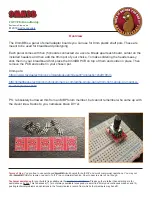
PET Plus User Manual 79
14.6 RESULT DISCREPANCIES
Insufficient drying is by far the most common problem, which leads to low results and high variance
between results.
The following is a list referring to some items that can also contribute to unexpected IV results from
the equipment:
•
Sample condition or size, resulting in variable results.
•
Dirty or hot follower - will give false high results.
•
New die “O” ring required - low IV
•
Inadequate gas pressure, e.g. empty bottle.
•
Poor vacuum to Dryer tubes - will give low and variable results.
•
Poor drying procedure - will give low and variable results.
•
Dryer temperature incorrect.
•
Holes in probe rod blocked.
•
Barrel inadequately cleaned - will give variable results and erratic graph.
•
Hot funnel used for sample.
•
Purge and full gas supplies not reaching the barrel.
•
GO key not pressed immediately after sample has been loaded into the barrel - will give
variable results.
The PET Plus is basically simple in operation and construction. No form of regular maintenance is
required except that the unit is kept in a clean condition.
14.7 POSSIBLE FAULTS IN PRESSURE CONTROL SYSTEM LOSS OF PRESSURE
1. Gas cylinder empty.
2. Malfunction of gas supply regulator.
3. Check all external screwed and compression joints using a soapy water solution if necessary,
especially where the supply pipe enters the equipment. Unscrew leaky joints and wrap PTFE
tape around male end, re-connect and tighten.
4. Check the condition of the seals at the top and bottom of the barrel, i.e. PTFE washer in die
retaining nut and PTFE washer where probe seals top of barrel.
14.8 BASIC ELECTRICAL CHECKS
Your equipment has been completely tested and checked for electrical safety before leaving the
factory.
Regular checks should be carried out on the instrument to establish that the instrument is safe to
operate.
Check all connections for mechanical tightness, an earth loop impedance check must be carried out
to all components which should be at earth potential. This should conform to local safety standards
and AMETEK recommends that this be carried out at least annually.
















































